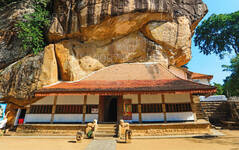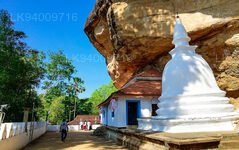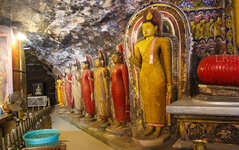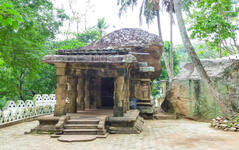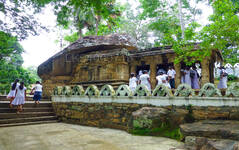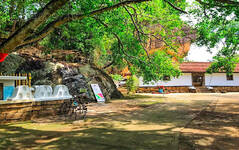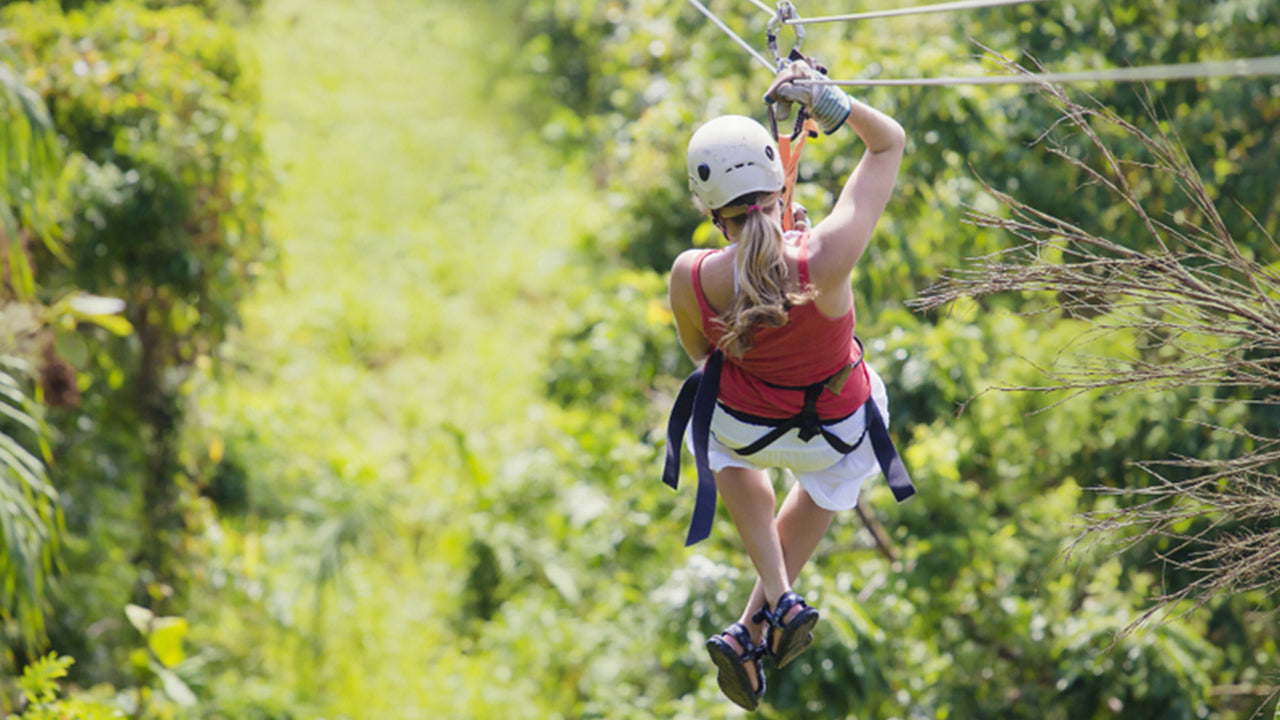
Kurunegala City
Kurunegala: Bustling city in Sri Lanka's North Western Province, featuring historic sites, vibrant markets, and a blend of modern and traditional culture.
Ridi Viharaya ෴ රිදි විහාරය
Ridi Viharaya lies about 20 kilometers away from the ancient kingdom of Kurunegala in a small village called Ridi Gama. This temple is said to be built by King Dutugemunu in the 2nd century BC as a memorial to the place where he found a silver (ridi) ore mine which was used to finance the building of the gigantic Ruwanweli Seya .
The great chronicle Mahavamsa describes the discovery of this mine by a trader
In a southerly direction from the city, at a distance of eight yojanas, silver appeared in the Ambatthakola-cave. A merchant from the city, taking many wagons with him, in order to bring ginger and so forth from Malaya, had set out for Malaya. Not far from the cave he brought the wagons to a halt and since he had need of wood for whips he wetit up that mountain. As he saw here a branch of a bread-fruit-tree, bearing one single fruit as large as a water pitcher, and dragged down by the weight of the fruit, he cut the (fruit) which was lying on a stone away from the stalk with his knife, and thinking: `I will give the first (produce as alms),’ with faith he announced the (meal) time.
And there came thither four (theras) who were free from the asavas. When he had greeted them gladly and had invited them with all reverence to be seated, he cut away the rind around the stalk with his knife and tore out the bottom (of the fruit), and pouring the juice which filled the hollow forth into their bowls he offered them the four bowls filled with fruit-juice. They accepted them and went their way.
Then he yet again announced the (meal) time. Four other theras, free from the asavas, appeared before him. He took their alms-bowls and when he had filled them with the kernels of the bread-fruit he gave them back.
Three went their way, but one did not depart. In order to show him the silver he went further down and seating himself near the cave he ate the kernels. When the merchant also had eaten as he wished of the kernels that were left, and had put the rest in a bundle, he went on, following the track of the thera, and when he saw the thera he showed him the (usual) attentions. The thera opened a path for him to the mouth of the cavern: `Go thou now also on this path, lay brother!’ When he had done reverence to the thera he went that way and saw the cave. Standing by the mouth of the cave and seeing the silver he struck upon it with his axe, and when he knew it to be silver he took a lump of the silver and went to his freight-wagons. Then leaving the wagons behind and taking the lump of silver with him the excellent merchant went in haste to Anuradhapura and told the king of this matter, showing him the silver.
As a gesture of gratitude The king decided to build a temple on the same ground and sent over 300 stone craftsmen to work on the temple. He also got a large gold plated Buddha statue to be bought from Dambadiva, India to be kept at the site. According to the the ancient book called “ridi vihara asna”, when the king Dutugemunu was coming to the competed temple with the Buddha Statue brought from india, the cart got stuck between some rocks and couldn’t be moved. The king disappointed, sat on the rock refusing to move until the cart is moved. Arhath Indragupta Thero ( the same thero who showed the merchant the way to the silver mine) saw this and made the statue to float in the sky and travel through air all the way to the temple.
Today this 2200 year old statue can be seen at the very spot that the silver ore was found inside the pahatha maluwa protected by a glass casing.
Although this area belongs to Kurunegala District, this area was part of the Kandian Kingdom during European occupation and King Kirthi Sri Rajasainha has made major renovations on this temple. Therefore most of the paintings and statues we see today belong to the Kandian Era.
About Kurunegala District
Kurunegala is the capital of the Wayamba Province in Sri Lanka and the Kurunegala District.Kurunegala was a royal capital for only 50 years, from the end of the 13th century to the start of the next, though even before this it was strategically placed in the middle of other majestic strongholds such as Yapahuwa to the north, Dambadeniya to the south and Panduwasnuwara in the east. Ethagala a rock reaching 316 meters, towers over the town, which is located at an altitude of 116 meters above sea level. The shape of Ethagala resembles an Elephant. A transport hub, it has a railway station, and several main roads linking important parts of the country.Kurunegala is situated about 94 km from Colombo, and 42 km from Kandy.
Most of Kurunegala's residents belong to the Sinhalese majority. Other ethnic minorities include the Sri Lankan Moors, Sri Lankan Tamils, Burghers and Malays. Residents from ethnic minorities live in all parts of the city, however, sizeable communities of Moors and Tamils also live in the areas of Teliyagonna and Wilgoda.
About North Western Province
North Western Province is a province of Sri Lanka. The districts of Kurunegala and Puttalam formulate North Western or Wayamba. Its capital is Kurunegala, which has a population of 28,571. The province is known mainly for its numerous coconut plantations. Other main towns in this province are Chilaw (24,712) and Puttalam (45,661), which are both small fishing towns. The majority of the population of Wayamba province is of Sinhalese ethnicity. There is also a substantial Sri Lankan Moor minority around Puttalam and Sri Lankan Tamils in Udappu and Munneswaram. Fishing, prawn farming and rubber tree plantations are other prominent industries of the region. The province has an area of 7,888 km² and a population of 2,184,136 (2005 calculation).
Wayamba is the third largest paddy producing area in Sri Lanka .Wayamba has a highly developed agricultural economy, growing a variety of fruits and vegetables, flowering plants, spices, oil-seeds in addition to the traditional plantation crops such as Coconut, Rubber and Rice. Rich soils and varied climate give Wayamba a potential for growing of virtually any crop.
In Wayamba or North western province, home for ancient Buddhist rock temples, magnificent citadels Panduwasnuwara, Dambadeniya, Yapahuwa and Kurunegala. Impressive remains of those citadels, palaces, Buddhist temples and monasteries provide exciting sight seeing to the visitors.
【Text by Lakpura™. Images by Google, copyright(s) reserved by original authors.】

